Case taking and analysis with children
Posted on
Introduction
For many years I have supported and used an approach to case taking with children developed by my colleague and friend Dr Pravin Jain of Mumbai, India.
I have found his approach practical and immensley rewarding. To me, it feels like a refreshingly authentic approach to homeopathic case taking, rather than the almost academic theorising that seems to typify a lot of our normal case taking and analysis.
In this series of articles I am pleased to share this information with you for the first time as I think it deserves a wider audience. Feel free to comment and make suggestions below!
The Problem
Historically many homeopaths seemed to prescribe only a limited range of "commonly known child remedies". This is because information on Pediatric materia medica was limited and there was no clear approach as to how to take the case in pediatrics. So everyone seemed to be observing children in their own way and using their own interpretations of these observations. There was no methodical, scientific approach and hence, consistent results were often lacking. Senior homeopaths, because of their experience, were achieving good results, but the rest of us were perhaps not so successfull!
In Pravins own words:
"Not surprisingly, in my initial days of practice I found pediatric cases to be very difficult to treat. Shivers used to run down my spine on seeing a mother accompanied by a child at my clinic. Even before a customary “hello!”, questions like “What do I ask? How do I ask? How does one judge the constitution of a child?” would jump into my mind. Unlike adults a child doesn’t tell you about its problem. The evaluation of these cases is usually based on the history that is provided by the guardian and on the physician’s INTERPRETATION. There is no definite method to understand and prescribe for a child.
So awkward was my state that whenever a mischievous child came into my clinic, I would instruct the mother to leave the child in the waiting room and come inside alone, so that I could completely concentrate on the case taking and avoid distraction by the hyperactive child. After the information from the mother was gathered, I called in the child, and then too my focus would be more on the expensive furnishings and trinkets in the clinic than the child, for fear of those being damaged by the tiny rogue."
In summary the problem was:
1. No special pediatric repertory/rubrics to make the task easier
2. No specific pediatric case taking approach
3. Very little pediatric MM
Dr Pravin Jain decided to specialise in the area of pediatrics. He was initially inspired by reading the famous 1977 study of Thomas and Chess who identified different Temperaments in children. This approach confirmed to him that there was a way of getting to homeopathic remedies in a more structured way then simply 'rubric hunting' in the repertory based on the words of the parent.
Over the years, he has tried to streamline the 3 major aspects of prescribing as follows:
1. Formulation of a scientific method of casetaking using consistent language
2. When taking and then analysing the case - using the same language/terminology (as used during casetaking) also used in repertory rubrics
3. When arriving at a group of remedies, once again using the same language/terminology in Materia Medica to help differentiate remedies.
Again in Pravin's words:
"The birth of my own daughter raised my anxiety. There were many questions in my mind …What about vaccinations? What is her constitution? Is she chilly or hot? How is her thirst? Common questions, the answers to which a homeopath ought to know seemed to me like an abyss I feared to look down into. My anxiety led me to refer the pediatric books in great detail. Simultaneously I started honing my observation skills, observing my daughter closely. After observing her, and correlating her behavior with the pediatric psychology books, I found the key to many of my questions. The same child who used to scare me in my clinic became a joy to observe.
Now I started asking the mother to wait outside, so that the mother did not distract from my observations!"
About Pravin
Pravin first developed this way of working and analysis after many years in practice and since decided in 2002 to specialise in child care. He has opened 15 branches across India each with its own Child Observation Area (COA). Pravin places great importance on being able to observe and interact with our little patients to gain a true understanding of their nature and problems. Although you may not be able to have a dedicated COA in your clinic setting I hope that the techniques and system explained here can be taken and adapted to your own situation.
At time of writing this article Dr Jain estimates that his clinics have treated over 10,000 little patients and have been achieving consistently good results
Clinic COA's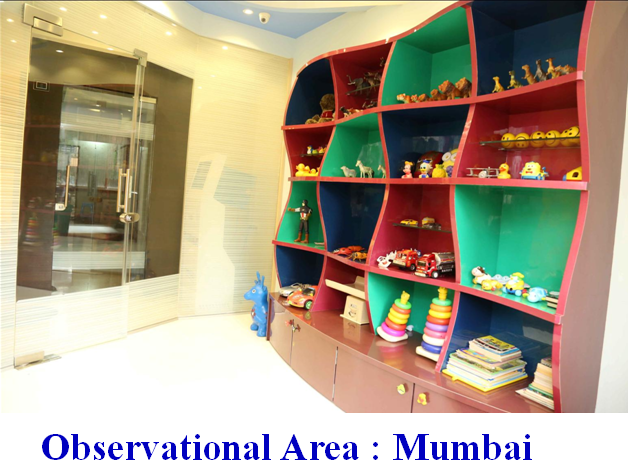
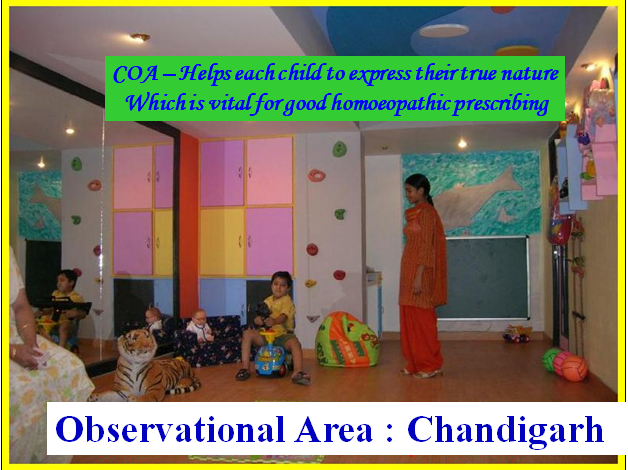
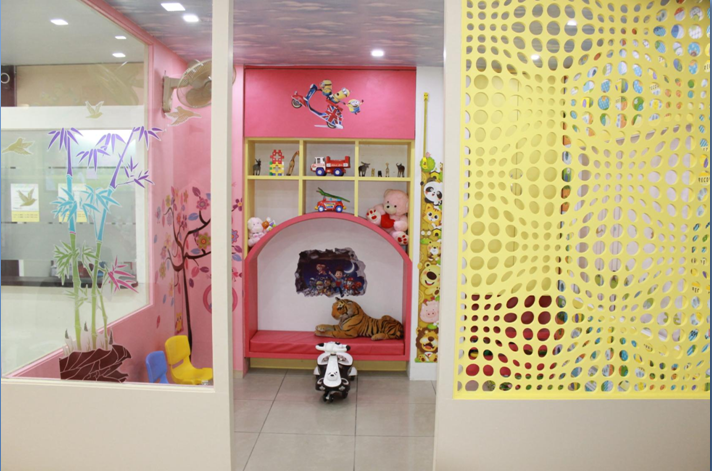
The Approach
Dr Jain finds it most important to observe and interact with children and not simply engage with the parent in 'rubric hunting'. He also analyses his pediatric cases in a very practical and straightforward way - using what is actually observed in the child's behaviour.
This article will explain in overview the approach Dr Jain takes. Subsequent articles will be cases to explain and support the approach.
For a detailed explanation and materia medica please consider purchasing Dr Jain's book 'The Essence Of Pediatric Materia Medica' which I am proud to support. To order please click on the image below :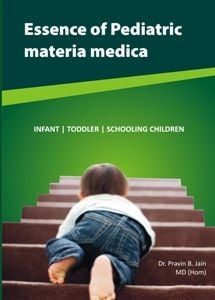
Here is an overview of the method used to observe and interact with children to arrive at well indicated remedies.
Each section will be explained in more detail below:
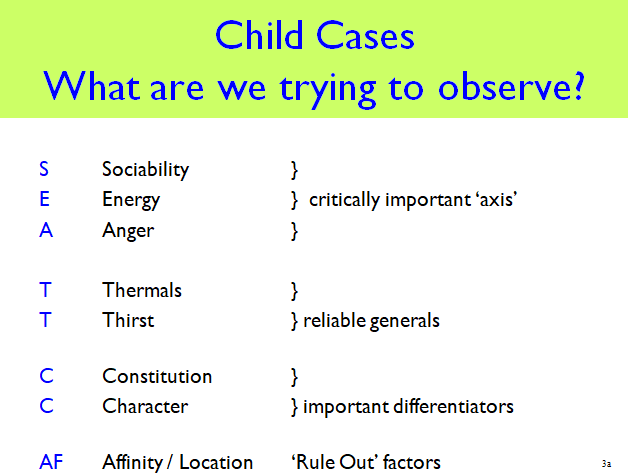
The idea is that by observation and interaction you decide on all of the above - with the 3 most important factors at the top - these are the SEA axis (Sociability, Energy, Anger).
Step 1 : Determine Sociability of child - is the child 'Approaching' or 'Withdrawing'?
This refers to the initial response to a new situation or a new stimulus. How a child responds to a new experience, such as meeting a person (guest, doctor, stranger), tasting a new food, or being in an unusual situation (doctors clinic). Observe the ease with which the child accepts and adjusts to changes in his environment and lifestyles. Some children move easily into new settings, taking very little time to join a new group of playmates, while others may observe the scene for a long time before going into a new situation or simply stay away.
Approaching children jump right in. Withdrawing children hold back cautiously until they feel comfortable.
Observation of the interaction between the child and mother, between the child and the doctor (you), between the child and a stranger, between the child and a new stimulus will help find the sociability of a child. Record this and use remedies reliably indicated and proven in practice as per this chart: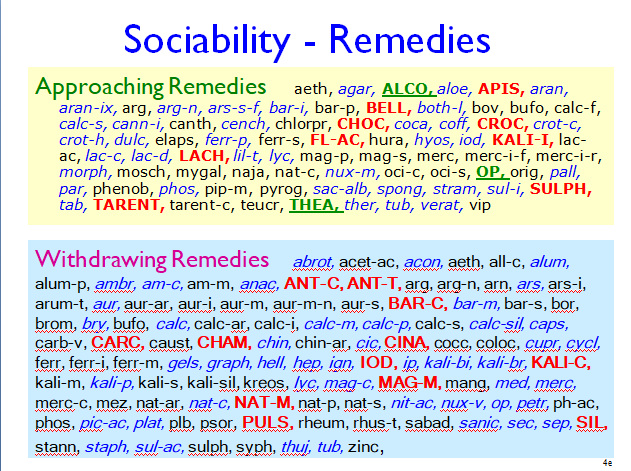
Step 2 : Determine Energy level of child - is the child 'Energetic and Restless' or are they 'Lacking energy'?
Make sure to differentiate between Mental energy/restlessness and Physical energy/restlessness as the remedies indicated for both vary! Does the child rush around the COA flitting from activity to activity? Do they engage in the more mental activities or do they stick to physical things such as running, skipping, jumping, climbing? And also look for lower than expected levels of energy.
Again there is a chart of well indicated remedies for each:
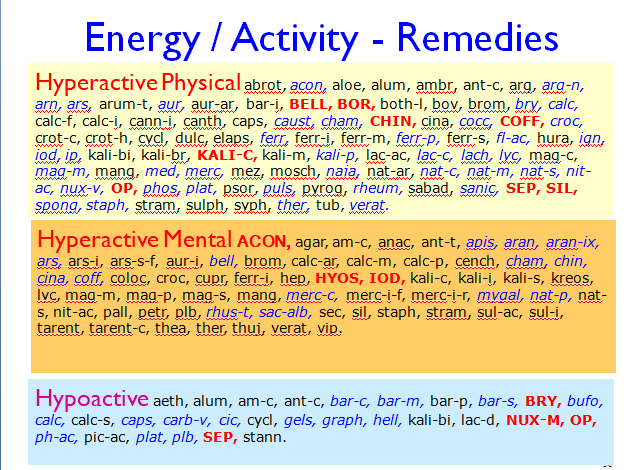
Step 3 : Determine Anger/Frustration response
If the child does not get their own way or what they desire, how do they react? You may need to interact personally with the child to make this determination!
Destructive reaction : smashing, ripping, knocking over/down, tearing paper / clothes often directed at the nearest available target
Non-destructive reaction : temper tantrum, throws themselves to floor, rolling around, writhing around, screaming loudly. Not directed at anyone or anything (unless further provoked)
Once again there is a chart of the remedies associated with each reaction:
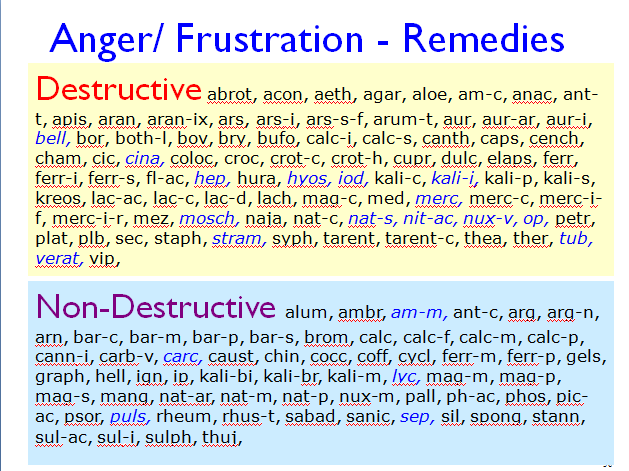
Brief example of 'Billy' and how he was analysed
A very friendly and affectionate toddler. Trouble is he’s a running and walking disaster zone! Rushes around everywhere. Throws terrible tantrums when he doesn’t get his own way and rolls around the floor shouting. He’s definitely on the ‘tubby’ side. His mother tells you he is very ‘picky’ about everything....his food and his possessions have to be ‘just so’. Can’t get to sleep at night. Wets the bed. Ezcema on hands. Mild asthma.
So Billy is:
S Approaching
E Hyperactive
A Non-Destructive
Once you have decided on the SEA axis you can quickly repertorise/cross these 3 'rubrics' to arrive at a small group of well indicated remedies. The following articles will show you real cases and analysis arrived at.
This approach allows you to spend far more time observing and interacting and less time on the technique of repertorisation - using just the 3 rubrics SEA will save you lots of time and guide you towards the indicated remedy!
Step 4 - Find the TT's!
What are the TT's? These are very reliable general modalities that help you narrow down the choice of remedy - Thirst and Temperature
Is the child thirsty or thirstless or neither? Are they hot or chilly or neither? Knowing this can be really helpful in case analysis.
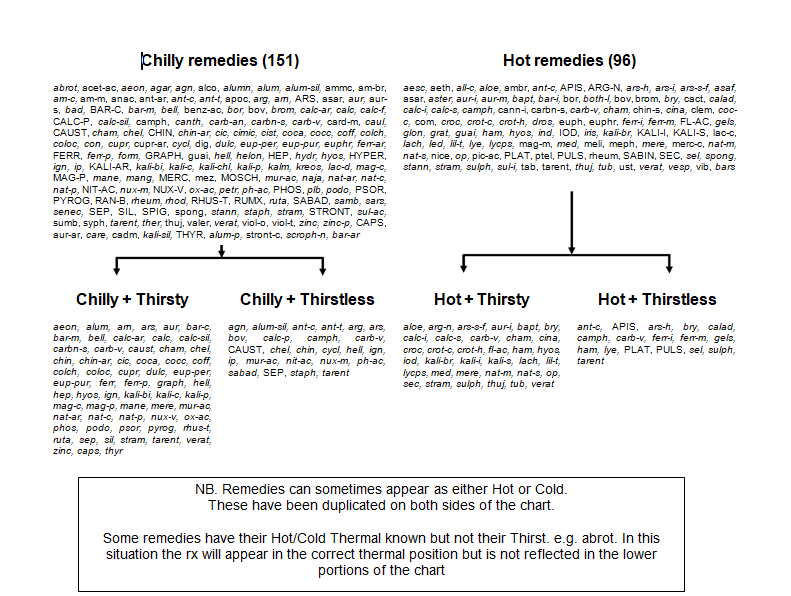
Step 5 - Find the CC's!
What are the CC's? These are the Constitution and Character of the child. Often called the Disposition and vitally important in helping you make the final choice of remedy. The Disposition or CC's either confirm or reject the remedy prescription as the disposition of the child absolutely must correspond with the known disposition of the remedy.
Examples - is the child : Happy? Neat and tidy? Do they do as they are asked e.g. could you please tidy up all these toys? (obedient) Are they Shy or Bashful? Are they a Bully? Are they Confident? Are they Rude? Do they Complain or Moan a lot? And so on.
Conclusion to First Article
In the next article I will present a worked case with repertorisation and follow up so you can see the approach in action!
Please comment on this article below. I read every comment personally and will reply if appropriate and I am sure Dr Jain would appreciate your feedback also.
Thank You
David Witko
FSHom UK (Hon)